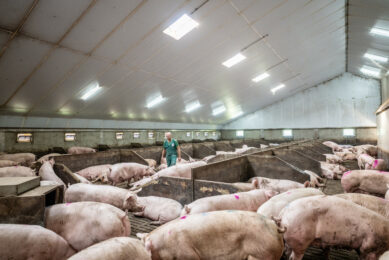Decline in Dutch antibiotic use in pigs
Antibiotic use in the Dutch agriculture sector has declined sharply in recent years, exceeding the objectives set by the government. Sales have shown a drop of 32% from 2009 to 2011.
The total sales of antibiotics in the Netherlands dropped nearly 32%, from 495 tonnes to 338 tonnes during the period 2009-2011, according to new data relating to the veterinary use of antibiotics published by LEI Wageningen UR.
This far exceeds the policy objective for 2011 set by the Dutch government, which was set at a 20% reduction in antibiotic use compared with 2009. Survey data on antibiotic use per animal species indicate a decrease in all five livestock sectors examined in 2011.
Sows and piglets
In 2011, the average use in sows/piglets is estimated to be 13 daily dosages per year (95% Confidence Interval: 10-16 dd/ay). In 2009 the use was 25 daily dosages per year (95% CI: 21-30 dd/ay). The large confidence intervals are mainly caused by the large variation in use that exists between different farms. 79% of the antibiotics were orally administered, probably predominantly in piglets.
In 2011 44% of the total antibiotic use in sows/piglets consisted of tetracyclines, 21% of penicillins and another 18% of trimethoprim/sulfonamides. 0.5% of the total use consisted of 3rd and 4th generation cephalosporins and 0.3% consisted of fluoroquinolones, which are likely to have been administered to young piglets before weaning.
In 2011, the use in sows/piglets was 13 daily dosages per animal year. However, in practice most antibiotics are likely used for the treatment of the piglets, and only incidentally for the sows. If it is assumed that 100% of the antibiotics are administered to the piglets, with an average weight of 12.5 kg, this would mean that an average piglet is treated with antibiotics during 13 days in the period from birth to the age of 74 days (at delivering to the fattening farm, at 25 kg).
Fattening pigs
In 2011, the average use in fattening pigs is estimated to be 8 daily dosages per year, of which 92% orally administered (95% Confidence Interval: 5-11 dd/ay). In 2009 the average use was 16 daily dosages per year (CI: 11-20 dd/ay).
In 2011 69% of the total antibiotic use in fattening pigs originated from the administration of tetracyclines and 16% from macrolides/lincosamides. 0.8% of the total use consisted of 3rd and 4th generation cephalosporins. Fluoroquinolones were not applied.
In 2011, the use in fattening pigs was 8 daily dosages per animal year. Assuming a production period of 117 days, 3 daily dosages (= 8 x (117/365) are administered to each fattening pig during its production period from 25 kg to slaughter weight. This fattening pig has also received antibiotics at the breeding farm (during 13 days), which brings the total exposure to antibiotics per fattening pig to approximately 16 days during its whole life from birth to slaughter at the age of 191 days.
If it is assumed that the average treatment weight of fattening pigs will be 30% lower than their average live weight, since younger animals are more likely to receive antibiotics than older animals, the estimation of the total life time true exposure increases from 16 days to a total of 17 days. Compared to 2009 this is a decrease of nearly 50%.
Source: LEI Wageningen UR report











